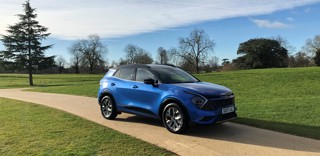Review
Few cars have played a more central role in the success of a brand than the Sportage has to Kia in the UK.
The SUV’s popularity culminated in 197,626 registrations for the version produced between 2016 and 2021 – well over double that of the third generation (95,626) on sale from 2010 to 2016.
In tandem with a push to electrification, the fifth generation will now play a major part in Kia UK’s goal of achieving 100,000 total registrations in 2022.
Kia’s is offering customers choice while other brands are slimming down the options.
Running on a new platform developed specifically for Europe, the new Sportage is available with petrol, diesel, mild hybrid and full hybrid drivetrains, with a plug-in hybrid being added in the spring.
There are 2, GT-Line, 3, 4 or GT-Line S trim grades and the option of four-wheel-drive in 4 or GT-Line S hybrid variants.
Prices range from £26,745 for the 2 spec with a 150PS 1.6-litre turbocharged petrol engine to £43,795 for the 265PS GT-Line S PHEV.
From launch, the mild hybrid diesel’s 54.3mpg fuel economy and 135g/km CO2 emissions make it the most frugal, while the full hybrid is the quickest.
The new Sportage’s styling is likely to be as divisive as that of its predecessor.
Its rear end alludes to the EV6 while its new face is dominated by a broad grille – topped by a slender reinterpretation of Kia’s ‘Tiger’ nose grille – and boomerang-shaped LED daytime running lights.
Inside, the EV6 influence is apparent in all but the 2 and GT-Line trims through dual 12.3-inch displays integrated into a single curved panel, housing the infotainment system and instrument cluster. A dial gear selector – used in the EV6 and Niro – is also fitted to automatic models.
Design innovations include front headrests sculpted to double-up as luggage hooks, and fast-charging USB ports on the inside of each front seat back.
I also liked the black panel on the dash which could serve up either climate or infotainment controls at the push of a button.
A 591-litre boot (1,780 litres with the back seats folded) is commodious, but more than 20 litres short of the class-leading VW Tiguan.
Standard on all Sportages are Android Auto and Apple CarPlay smartphone compatibility; front and rear parking sensors and a reversing camera; lane-follow assist; and lane-keep assist.
The safety tech continues with forward collision avoidance assist, which includes sensors monitoring pedestrian, cyclists and junctions.
The sporty GT Line adds 19-inch alloys (18-inch wheels on the HEV), a 12.3-inch infotainment display and 4.2-inch instrument cluster, suede and leather upholstery, keyless entry, adaptive cruise control and a seven-year subscription to Kia Connect (formerly UVO Connect), which allows users to connect with their vehicle via a smartphone app.
The Sportage 3 has 18-inch alloys, cloth and faux leather seats which are heated front and rear, a heated steering wheel, keyless entry, adaptive cruise control and that EV6-style curved display.
Sportage 4 highlights include a panoramic sunroof, Harman Kardon sound, wireless smartphone charger, 360-degree parking monitor, the blind spot view monitor system also on Kia, Hyundai and Genesis models, and a remote parking system that allows the car to be moved using the key fob.
In GT-Line S guise the Sportage features the exterior styling treatment of the GT-Line with equipment levels of the 4. Plus front occupants have powered, ventilated seats and the boot opens electrically.
With such a vast range to consider, Kia’s management told me that customers heading into its dealerships should be assured that the brand “has a car for them”.
If my test drives and the vast spec sheets proved anything, though, it’s that customers will need a little guidance on which Sportage suits their needs best.
 Q&A with Kia UK marketing director Sanka De Silva
Q&A with Kia UK marketing director Sanka De Silva
Just how important is the new Sportage to the success of Kia overall?
At 50% of the sales mix, it’s part of our success now and part of our growth aspirations in the future. Kia UK planned to deliver 90,000 cars in the UK in 2021 and we did that. Our aim is to get to 100,000 this year and Sportage is a big player in that.
What is the marketing plan to get it in front of customers?
We started the marketing process in December – largely introducing that car through social media – and we have a seven-month campaign mapped out. Until now we have been in a pre-launch phase. Now we will be across television, radio, social and digital. Television adverts start now and run for two months and then we have a further eight weeks of TV advertising starting in April. Dealers have the assets they need to do a Sportage takeover of their showrooms and really put the new model in front of potential customers. In March it will also form a part of an electrification roadshow that will take place across our retail network.
Two months into some softer marketing activity, what has the response of customers been like?
To date, there are 4,500 pre-orders. They have been generated largely by press coverage, word of mouth and awareness among existing customers, so there is huge potential there. It’s a great position to be starting the new year in.
Electrification is a core part of the new Sportage package. What do you expect to be the most popular configuration?
The hybrid (HEV) model is likely to be the big seller and, going on its popularity in the Sportage in 2021, the GT-Line is likely to be the most popular trim grade. At the end of the day, we wanted to give customers choice, though. That’s why there is still diesel in the line-up alongside petrol, mild hybrid and – from Q2 this year – a plug-in hybrid that will suite fleet customers. It’s a great position for our dealers to be in. A customer walking in saying ‘I’m undecided’ can be assured that there is a drivetrain option that will suit their needs. A lot of brands claim to be electrified leaders, but we have the products to back that claim. In 2022, we will have a total of 10 electrified models on offer.
Author:
Tom Sharpe
Former news and features editor (left May 2023)
Factsheet
Price: £26,745 to £43,795 (incl. PHEV)
Engines: 1.6, 1.6 MHEV and 1.6 Hybrid petrol; 1.6 and 1.6 MHEV diesel
Performance: 7.7 to 11.7 seconds to 62mph; 108 to 120mph top speed
Transmission: 6sp manual; 6sp auto; 7sp DCT
MPG: 40.4 to 54.3
CO2: 129 to 158g/km

















Login to comment
Comments
No comments have been made yet.